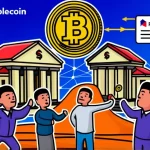Telcoin (TEL) Price Predictions 2025-2031: Can This Altcoin Recover?

Telcoin (TEL) Price Predictions 2025-2031: Can This Altcoin Rise from the Ashes?
Telcoin (TEL), launched in 2017, set out to transform remittances and mobile payments by marrying blockchain technology with telecommunications. After soaring to a peak of $0.0649 in 2021, it’s been a brutal descent, leaving investors wondering if this altcoin can claw its way back to relevance or if it’s just another forgotten project in the crypto graveyard.
- Mission Focus: Telcoin targets low-cost, borderless mobile payments for the unbanked via blockchain-telecom integration.
- Price Forecast: Predictions suggest TEL climbing from a high of $0.006755 in 2025 to an average of $0.028148 by 2031.
- Current State: Trading at $0.003683 with stagnant momentum, TEL is stuck in a consolidation rut.
Telcoin’s Vision: Blockchain Meets Mobile Finance
Telcoin’s core idea is straightforward yet ambitious: use blockchain to enable fast, dirt-cheap financial transactions directly through mobile devices, bypassing the bloated fees of traditional remittance systems like Western Union, which can gouge up to 10% per transfer. The Telcoin Network, powered by its native token TEL, partners with telecom providers to integrate crypto transactions into mobile carrier billing systems—a novel approach aiming to reach the unbanked and underbanked, a demographic numbering over 1.4 billion globally per World Bank stats. With a maximum supply of 100 billion tokens, 25% were sold in a 2017 crowdsale, and 15% were reserved for the dev team, including a 5% liquidity buffer. It’s a structure designed for sustainability, but in crypto, even the best plans can get torched by market chaos.
For context, remittances are funds sent by individuals—often migrant workers—back to their home countries. Imagine a Filipino worker in Dubai sending $200 home monthly; via traditional channels, they might lose $20 to fees. Telcoin wants to slash that to pennies using decentralized ledgers for near-instant transfers. This mission aligns with the ethos of financial freedom and decentralization we champion, even if TEL isn’t Bitcoin. It’s about sticking it to the middlemen and empowering users outside the grip of legacy banking. But lofty goals don’t guarantee success—execution and adoption are everything.
TEL Price History: From Boom to Bust
Telcoin’s price journey reads like a crypto cautionary tale. It bottomed out at a measly $0.00006516 during the COVID market panic on March 13, 2020, before rocketing to an all-time high of $0.0649 on May 11, 2021, fueled by the bull run’s speculative mania. That peak likely tied to broader altcoin hype and early buzz around Telcoin’s telecom partnerships, though specific catalysts remain murky. Since then, it’s been a bloodbath—down to $0.002484 in 2022’s bear market, scraping $0.0009 by November 2023, and now limping along at $0.003683 as of October 29, 2024, with a pitiful 0.44% uptick. That’s not progress; it’s a flatline.
Technical indicators don’t inspire much confidence either. The RSI, or Relative Strength Index—a tool gauging if a token is overbought (above 70) or oversold (below 30)—sits at 42.48 for TEL, signaling a neutral, directionless market mood. The MACD (Moving Average Convergence Divergence), which tracks momentum, is flat, showing no clear trend. Bollinger Bands, used to spot volatility and potential breakouts, are tight, hinting at an imminent move—but up or down? Flip a coin. TEL is in consolidation, stuck in a holding pattern with weak momentum. For newbies, these metrics are just snapshots, not prophecies; crypto markets often defy logic, driven by hype as much as data.
Price Predictions for 2025-2031: Hope or Hype?
Now, let’s talk forecasts, but with a giant disclaimer: these numbers are speculative as hell. Crypto markets are a circus—swayed by regulatory bombshells, meme-driven pumps, or a billionaire’s stray tweet. Still, analysts have crunched numbers for TEL, projecting a slow grind upward. For 2025, they see a range of $0.003504 to $0.006755, averaging $0.004630. By 2026, it’s $0.008257 to $0.010508, averaging $0.009383. The climb continues through 2027 ($0.012010-$0.014261, avg. $0.013136), 2028 ($0.015763-$0.018014, avg. $0.016889), 2029 ($0.019516-$0.021767, avg. $0.020642), 2030 ($0.023269-$0.025520, avg. $0.024395), and peaks in 2031 at $0.027022 to $0.029274, averaging $0.028148. That’s nearly an 8x jump from today’s price—if the stars align. For a deeper look into these projections, check out this analysis on Telcoin’s future price potential.
Let’s cut the crap, though. These rosy targets are educated guesses at best, akin to predicting the weather during a hurricane. A projected high of $0.029274 by 2031 still falls short of the 2021 ATH of $0.0649, so even optimists aren’t betting on a full comeback soon. And honestly, why should they? Crypto is a brutal arena; for every token that moons, ten others get buried. Could TEL defy the odds with mass adoption? Sure. Could it tank to sub-penny levels in the next bear market? Absolutely. If you’re eyeing these numbers as gospel, you’re likely new to this game. Do your own digging, and don’t fall for shills promising lambos.
Fundamentals: What’s Fueling Telcoin’s Fire?
On the upside, Telcoin isn’t just another shitcoin with a whitepaper and a dream. Recent funding to launch the Telcoin Digital Asset Bank in the U.S. is a bold step toward legitimacy. This crypto-native bank could offer regulated financial services, potentially bridging the gap between decentralized tech and mainstream users. Alongside it, eUSD—a stablecoin likely pegged to the U.S. dollar—aims to provide a steady medium for remittances and transactions, dodging the volatility that plagues tokens like TEL itself. Regulatory approvals in major jurisdictions (though specifics are vague) further bolster credibility in an industry often stuck in legal limbo. The Telcoin Association, a Swiss non-profit representing global telecom stakeholders, adds governance structure to the mix.
These moves tap into real trends. Smartphone penetration is exploding—over 6.8 billion users worldwide by 2024 per Statista—and mobile banking is a lifeline in regions with scant traditional infrastructure. If Telcoin can onboard even a fraction of this market, especially in high-remittance corridors like Asia or Africa, it could carve a niche. Think of it as Bitcoin’s rebellious cousin: not striving for pure decentralization or store-of-value status, but gunning for practical utility in a specific sector. We’re all for projects that disrupt the status quo, and TEL’s focus on the unbanked echoes the original cypherpunk vision of financial sovereignty—albeit with a corporate twist.
Risks and Roadblocks: Why TEL Could Stumble
But let’s not sip the Kool-Aid just yet. The fintech and crypto remittance space is a shark tank. Ripple (XRP) already dominates cross-border payments with partnerships galore, boasting transaction speeds of 3-5 seconds and fees often under a cent via its RippleNet. Stellar (XLM) also competes, focusing on low-cost transfers with a growing ecosystem. Telcoin’s transaction costs and speeds remain less documented, but without a clear edge, it risks being outpaced. Market volatility is another beast—crypto isn’t a safe haven; a single bear cycle could gut TEL’s value overnight, as we saw in 2022. Regulatory risks, despite approvals, aren’t gone; a policy flip in the U.S. or elsewhere could kneecap even well-intentioned projects.
Then there’s TEL’s own history. Post-2021, it’s failed to sustain momentum—why? Was it lack of adoption, poor marketing, or just altcoin fatigue as Bitcoin dominance creeps back up (currently over 55% of total market cap per CoinGecko)? Without clear answers, betting on a revival feels like a coin toss. Let’s play devil’s advocate for a second: what if smartphone adoption in developing nations surges beyond forecasts, and Telcoin locks in key telecom deals? Could it become the killer app for crypto remittances? Possibly. But banking on “what ifs” in a market this cutthroat is a recipe for empty wallets.
Telcoin’s Place in the Crypto Revolution
Telcoin embodies the altcoin struggle: balancing real-world utility with the savage realities of speculation. Its mobile-first approach could empower millions outside traditional finance, resonating with our push for decentralization and privacy. Yet, it’s not Bitcoin, nor does it aim to be—TEL fills a niche BTC doesn’t touch, much like Ethereum’s smart contracts or Monero’s anonymity. We’re not maximalists to the point of blindness; innovation across blockchains drives this financial uprising, even if Bitcoin remains king. Still, TEL’s path is fraught. The planned bank and eUSD are promising, but execution is everything—screw-ups or delays could doom it to irrelevance.
For investors, TEL is a high-risk, high-reward gamble. Its current price action screams “snooze,” and reclaiming past glory seems a distant dream without a major catalyst. If you’re in, brace for turbulence; if you’re out, don’t let FOMO cloud your judgment. Crypto isn’t charity—every token must prove its worth, and Telcoin’s jury is still out. Could its telecom focus be the spark remittances need, or is it too niche to scale? That’s the million-dollar question.
Key Questions and Takeaways for Crypto Enthusiasts
- What sets Telcoin (TEL) apart in the blockchain space?
Telcoin blends blockchain with telecoms to deliver low-cost mobile remittances, targeting the unbanked with a practical use case beyond pure speculation. - How has TEL’s price fared historically, and where does it stand now?
After peaking at $0.0649 in 2021, TEL crashed hard, now trading at $0.003683 as of October 2024 with no momentum and a stagnant market vibe. - Are the 2025-2031 price predictions for Telcoin believable?
Forecasts peg TEL at a high of $0.006755 in 2025, rising to an average of $0.028148 by 2031, but these are wild guesses in a volatile market—don’t bank on them. - What recent moves could push Telcoin forward?
Funding for a U.S.-based Telcoin Digital Asset Bank, the eUSD stablecoin launch, and regulatory nods signal potential for mainstream traction if done right. - What are the biggest threats to Telcoin’s success?
Cutthroat competition from Ripple and Stellar, crypto market crashes, and regulatory curveballs could derail TEL, alongside its own history of fading momentum. - Is Telcoin a smart addition to a crypto portfolio?
TEL offers long-term upside for believers in mobile remittances, but it’s a risky bet—only jump in if you’re ready for the wild swings of altcoin territory.
Telcoin’s saga is a microcosm of the broader crypto gamble: daring ideas clashing with harsh market truths. We’re rooting for any project that chips away at centralized finance’s stranglehold, but we won’t peddle false hope. TEL has a shot at relevance if it nails its vision, but the odds are steep, and the competition is ruthless. Do your homework, ignore the hype machines, and remember—whether you’re a newbie or an OG, crypto rewards the bold but punishes the naive. Telcoin’s future? It’s anyone’s guess, but it’s sure as hell not a guaranteed moonshot.



